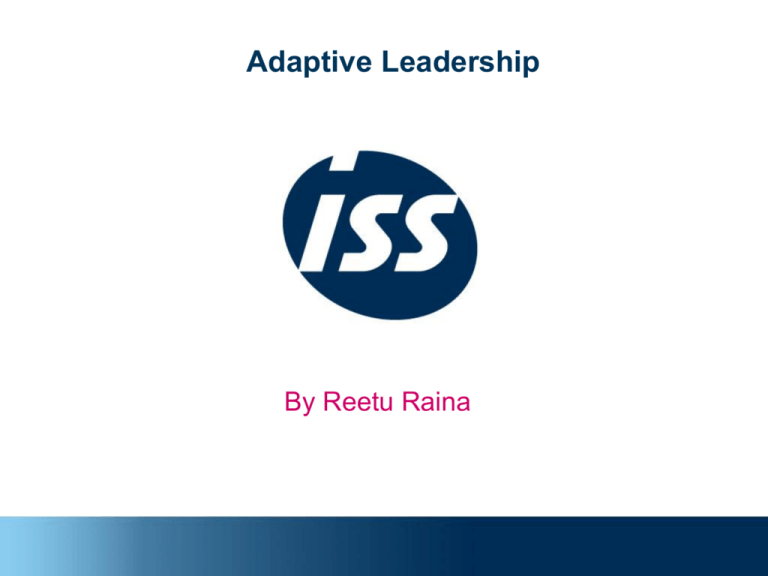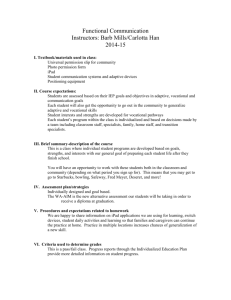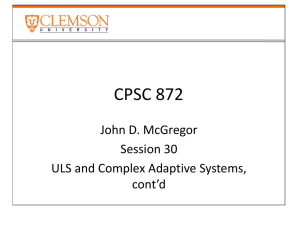Adaptive Leadership
advertisement

Adaptive Leadership By Reetu Raina Current Scenario The most certain thing in today’s business environment is Uncertainty ???? So we need to prepare leaders for unknown The Need for New, Adaptive Leadership Complex, Significant Challenges Myth that Better Execution and Improving Operations Alone will Accomplish Needed Results What is Adaptive Leadership Adaptive leadership is given to impacting the environment. It addresses a very active form of leadership, not a passive effort taken merely to adjust to circumstances as found. Biology teaches that relationships between living entities are circular and interactive. Our organizations are also living systems, being composed not just of capital goods and technology, but of people. Leadership Level and Associated Tasks Facing adaptive challenge, creating meaning. Innovation, change, dealing with paradigm shifts Adaptive Leadership, Relational Dialogue Social Leadership Wholistically framing issues, creating context for dialogue, managing creative conflict and tension. Leadership Level III Stimulating/consolidating organizational learning Inter-Personal Influence Relationship-Based Leadership Creating commitment, alignment, motivation, spirit, teamwork, and political skill Leadership Level II Personal Dominance Leader-Based Leadership Setting direction, priorities, mission, vision, goals, purpose and taking immediate action Leadership Level I Adapted from Drath and Heifetz Knowing-Doing” Gap Leaders always don’t fall more because of lack of execution than lack of vision Why Gap Pfeffer and Sutton suggests five reasons Talk over the action Memory Substitutes for Action Fear Prevents Action Measurement Obstructs Good Judgment Internal Competition – Friend becomes Enemy Talk Talk is cheap Talk makes you look clever Education system oriented towards talk Talk in seminars, write papers No need to act Companies talk about acting But don’t act Overcoming the gap Action oriented organization & culture Reward action not discussion Trust people Coaching / Mentoring / Master-Apprentice Embedded training - On the job training Reduce gap between learning and doing Repeat attention Simplicity One or two things at a time Adaptive Leadership Challenges… “Making progress on these problems demands not just someone who provides answers on high, but changes in our attitudes, behavior, and values. To meet challenges such as these, we need a different idea of leadership and a new social contract that promote our adaptive capacities, rather than inappropriate expectations of authority.” The leadership challenges are complex: there is no one “right” answer vs. Real risk must be balanced against reward The leader does not impose a solution: the final solution emerges from the dialogue of all the parties All parties learn from one another—and learn more about the situation in the process Everyone must adapt their perspective in order for a solution to emerge The Dangers Adaptive Leaders Face Marginalization Diversion Attack Seduction Loss Adaptive Leadership Strategies Get on the balcony Maintain “sacred heart” Anchor yourself Manage your hungers Think politically Orchestrate the process Hold steady “Getting on the Balcony” Gain a wholistic perspective Systems thinking Technical vs. Adaptive Work Simultaneously on the dance floor and above it on the balcony Observe patterns and people Discern true meanings and feelings, particularly of authority figures; “song beneath the words” Personal reflection “Thinking Politically” Dance the relationship dance Encourage supporters Stay close to opponents Court the undecided Acknowledge the loss- uncertainty, disloyalty, and incompetence- change brings Allow time for transition but leave behind those that cannot make the change “Orchestrating the Process, Particularly Conflict” Establish safe, stress-ful holding environment, like a pressure cooker Moderate temperature to pace work progress Let issues ripen when needed Balance pain of loss with positive possibility of change for their future Give the work back to the people Make interventions short and simple Don’t take personal attacks personally “Hold Steady!” Take the heat Patiently let issues ripen Focus attention on the issues Ask lots of real tough questions Suspend your reality ENCOURAGE RISK AND EXPERIMENTATION Do you have a domestic strength or industrial strength pressure cooker in your community, organization, your team, your family, or your own ego? “Manage Your Hungers” Respect the ready availability of and need for power, control, affirmation and importance Intimacy and delight needs must be met appropriately Manage your grandiosity remembering people see you more in your role than as a human person Use transitional rituals to demarcate your roles “Anchor Yourself” Don’t confuse one’s self with one’s professional role Identify a truly trustworthy confidant who can really tell you what you need to hear Do not use allies as confidants Find a sanctuary for retreat, rejuvenation, and personal reflection Put yourself on the line in leading again! Learning Methods for Adaptive Leadership “Case in point” Classroom as “studio laboratory” Success and failure stories sharing and analysis Owning up to your part of the mess “Empathic Imagination” and compassion development Intense monitoring of feelings and reflection Journaling Simulations Personal Assessments- 360 degree feedback Coaching Leadership Development Planning Current situation challenge, support, re-assessment “The Fog” and other metaphors Your Adaptive Leadership Challenges What are two adaptive leadership challenges you face and what is your role in catalyzing relational dialogue and adaptive learning to solve them? THANK YOU







